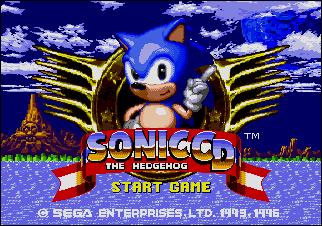 It's ironic that the first and
last Sonic game for the Sega CD was never even touched by the man
the series is usually attributed to (Yuji Naka). Sonic CD is, in
fact, the brainchild of director (and Sonic's designer) Naoto
Ohshima. CD is a stark contrast to the classic Sonic games in both
style and feel, sporting a uniquely anime flair and a surreal
fantasy story with psychadelic environments. Perhaps this is closer
to the Sonic ideal that Ohshima envisioned as opposed to the Uekawa
ideal that has come to be. Whatever the case, even the blue blur
himself couldn't save the ill-conceived Sega CD, and Sonic CD --
like every good game for the system -- is relegated to the status of
cult favorite. It's ironic that the first and
last Sonic game for the Sega CD was never even touched by the man
the series is usually attributed to (Yuji Naka). Sonic CD is, in
fact, the brainchild of director (and Sonic's designer) Naoto
Ohshima. CD is a stark contrast to the classic Sonic games in both
style and feel, sporting a uniquely anime flair and a surreal
fantasy story with psychadelic environments. Perhaps this is closer
to the Sonic ideal that Ohshima envisioned as opposed to the Uekawa
ideal that has come to be. Whatever the case, even the blue blur
himself couldn't save the ill-conceived Sega CD, and Sonic CD --
like every good game for the system -- is relegated to the status of
cult favorite.
-- Quick Jump
--
[Story
| Gameplay
Info | Zones
| Comparison
| Codes
| Behind
the Screens | Cultural Notes | Miscellanea]
-- Story
--
On one month of every
year, a mysterious phenomenon occurs in the sky above Never Lake: a
tiny, beautiful planet appears for a brief period of time. Known
variably as the Little Planet or "The Planet of Miracles", the
sphere is home to seven mysterious gems that control the passage of
time. When these Time Stones awaken, miracles are sure to ensue...
deserts turn to jungles and polluted waters become pure thanks to
the time shift caused by the mystic jewels. It doesn't take an I.Q.
of 300 to see the potential for gain, but Eggman's got one anyway so
naturally he cites the Little Planet as the location for his next
metallic fortress. As soon as the Planet appears, the Doc chains it
down to a nearby mountain bearing, like everything else he builds,
his own ugly mug. Eggman then takes advantage of the Little Planet's
lack of boundaries on time and conquers the past so that he controls
the future. Where's a speedy blue hedgehog when you need him?
Why, he's on his way to Never Lake, of course.
With absolutely no clue of Eggman's latest ambition, Sonic arrives
on the shores of the lake and is shocked to see the legendary Little
Planet chained to the local terrain. It doesn't take our hero three
guesses to figure out the perpetrator of this deed, so Sonic dashes
up one of the chains to free the Planet and throw a wrench into his
rival's latest scheme. Unfortunately, Eggman had been clued in to
his enemy's arrival, and had ample time to make preparations...
Meanwhile, a young girl hedgehog named Amy Rose
(aka Rosie the Rascal) is lured to the Little Planet by a card
reading that told her of a destined encounter with Sonic. Once
there, Amy becomes the perfect target for Eggman to make sure he's
got Sonic's attention and to show off his latest, most sophisticated
creation to date: Metal Sonic. Metal Sonic, a robot duplicate of our
hedgehog hero, was designed to match Sonic's every move and even
surpass his own namesake speed. This deadly new rival kidnaps Amy in
front of Sonic's very eyes, then escapes with his prize to Eggman's
base.
--
Gameplay Info --
The mascot code states
that, at some point, every hero must have a game about time travel.
This is Sonic's, and it fills the contingency quite nicely without
falling into any of the cliché traps such a concept is prone to.
The first thing you have to know about Sonic CD
is that it controls a bit differently from traditional Sonic games.
While the formula of running, collecting Rings, and spinning enemy
robots is the same, Sonic moves with a much stiffer, more precise
control. The level designs reflect this in that they seem to have
alot more stuff going on in smaller areas as opposed to the broad
and open style of other games in the series.
Regardless of the alternate control scheme, CD
plays just like a true blue-blooded Sonic title. The basic object is
to get to the end of the stage (left to right) within the ten minute
time limit, with plenty of loop-de-loops, Rings, springs, and other
Sonicy things on the way. Monitors contain the classic five
power-ups: Highspeed for a temporary burst of speed, Big 10 Ring for
10 Ring bonus, 1-Up for an extra life, Muteki for a temporary streak
of invulnerability, and Barrier for a one-hit damage guard. Rings
are scattered about and function in the traditional way: collect a
bunch, lose 'em if you get hit, lose a chance if you get hit with no
Rings, bonus points for all Rings on-hand at the end of a Zone (and
the chance to enter the Special Stage if you've got at least 50).
Yellow springs bounce you a short distance, red springs bounce you
really far, and Point Markers mark your place in the Zone should you
lose a chance.
Sonic's got his usual running and spinning
maneuvers, along with the Spin Dash and the new Peel Out. The Spin
Dash functions somewhat differently than usual; it's more like a
slingshot and is comparatively slow. A much easier means of gaining
speed quickly is the Peel Out, which is performed by pressing up on
the D-pad and one of the action buttons. Sonic will stand in place
and kick up dirt until his legs blur and eventually take on a figure
eight shape. Let go of the D-pad to cut loose, but keep in mind you
can still take damage while performing the Peel Out.
There are a total of seven stages each with
three sub-divisions that, in any other Sonic game, would be known as
Acts. I think one of their primary goals in creating Sonic CD,
though, was to confuse the hell out of series fans so they decided
to call them Zones. What would otherwise be known as "Zones" have no
official name unless you believe the US instruction manual which
refers to them as "rounds". You with me? Anyway, the first two Zones
are actual level while the third is the boss round and not much
more. Bosses are unique in that they only take three or four hits a
piece to destroy, but the trade off is that just landing a
hit is an accomplishment. Eggman's machines have some particularly
nasty defense systems this time around.
|
New to the mix are
time warp signs. This is where Sonic CD's time travel system
comes into play. In each Zone, you'll find a number of signs
marked "Past" or "Future". Cross a sign to spin it around,
making it useless for the rest of the stage. Once the sign has
been turned, it will appear in the lower left-hand corner of
the screen. While the sign is down there, start running. Once
you've attained max speed, a trail of stars will appear behind
Sonic and the sign will begin flashing. Should you lose speed
or come to a stop during this phase, you'll blow the warp and
the sign will disappear. If you're able to hold max speed for
about three seconds, you'll warp to the time displayed on the
sign. For example: if you're in the Present and you spin a
"Past" sign, you'll be warped to the past. If you're in the
Past and you spin a "Future" sign, you'll be warped to the
Present. Simple, huh?
With this time travel system in mind,
each level has four different forms:
Past -- The stage as it used to be in times past. Eggman's
already been here and has left one robot machine in each Zone:
destroy it to enable the Good Future, instantly eliminating
all enemies in the Past and Good Future scenarios for that
Zone. Also look for the Metal Sonic hologram in each Zone:
he's usually harassing the local wildlife. Destroy the
hologram to see animals frolicking happily around the stage.
If that's your thing, I mean...
Present -- This is the time you begin each Zone in,
regardless of what time period you were in when you completed
the previous stage. You can play it straight or pop into
another time period for a visual change and the chance to make
a Good Future.
Future -- This is the Future you get when you head there
before destroying the robot machine in the Past. Eggman's long
since assumed control, leaving a nasty, grimy, polluted mess
akin to all those factory Zones he usually hangs out in. Zone
3, the boss round, always takes place in the Future unless
you've made a Good Future in both of the previous Zones.
Good Future -- The ideal scenario. This is the level you
get when you go to the Future after destroying the robot
machine in the Past. There are no enemies to be seen, and
animals prance happily about the beautiful scenery which is
usually an ideal marriage of technology and nature. If you've
made a Good Future in Zones 1 and 2 of any stage, Zone 3 will
automatically be converted to a Good Future.
The ideal journey for each stage, as
mentioned, is to go to the Past and destroy the robot machine.
From there, you can just clear the stage or head to the Future
to view your handiwork. The boss round will always be in the
Future: if you've made Good Futures in both of the action
stages, the boss round will automatically be a Good Future. To
get the good ending, every Zone in the game must have a Good
Future. |
Palmtree Panic -- The requisite
tropical stage, and your first chance to check out one of the
Sonic CD graphical quirks. Note that if you reach a high
enough point in the stage, the background flips (kind of like
NiGHTS in 2D). The vertical ramps are a good place to check
this out. You'll find Amy Rose running around at the very end
of Zone 1: if she grabs hold of you, she won't let go. Jump to
evade her wicked grasp of temptation. Other enemies you'll
encounter include:
- Mosqui -- Mosquito bots that fly along a straight
horizontal plane until Sonic passes underneath, at which
point they dive straight downward and stick into the ground.
- Batabata -- Not to be confused with the Sonic 1 fish
bots of the same name, these butterfly bots that simply fly
from one side of the screen to another. ("Batabata" is
Japanese onomatopoeia for a flapping noise.)
- Anton -- Unicycling ant bots that simply roll back and
forth along a plane.
Boss: Eggman attacks you with his EGG-HVC-D01. With
spiked shoesies and bumper hands that act as shields, your
only real chance to attack is right before he charges, at
which point he retracts the shield-bumper-hand things leaving
himself vulnerable. A bumper falls off after each hit, making
him a bit easier to attack each time.
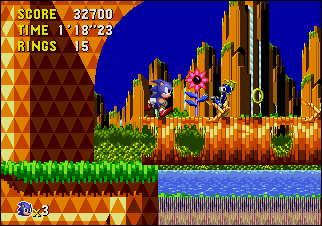 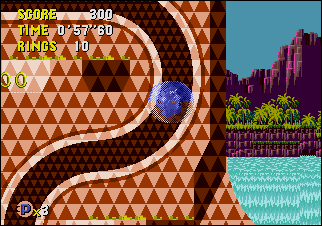 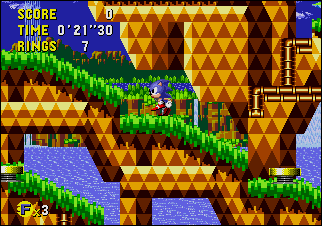 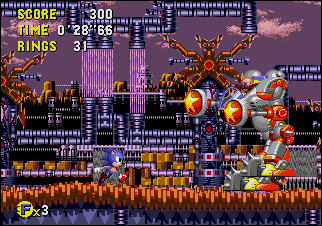 |
Collision Chaos -- There are alot
of really, really weird Sonic Zones, but this one --
possibly more than any other -- absolutely lacks description.
It is one of those pinball stages, so most of the time you're
being knocked about praying you don't land on spikes. At the
very beginning of Zone 1, you're introduced to Metal Sonic who
makes off with Amy, the metallic pervert. Enemies you'll
encounter include:
- Kamakama -- Mantis bots which look slightly less
threatening than Sonic 2's Kamakillers, but attack in the
same sort of way. Unlike their slightly more annoying
cousins, Kamakamas are capable of moving back and forth in a
small area. ("Kama" is the Japanese word for sickle and
"kamakiri" is the word for mantis.)
- ??? -- Nameless flying bots hang on walls and drop off
to fly toward you similar to Sonic 1's Meleons.
Boss: Eggman's hanging around at the top of a
pinball arena and your job is simply to bounce, bump, and flip
your way up to him. He drops mines to slow you down, but once
you've made it to the top, just jump and hit him three times.
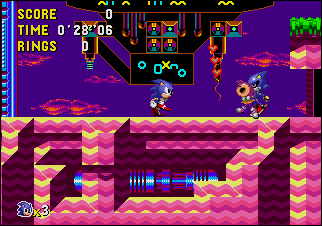 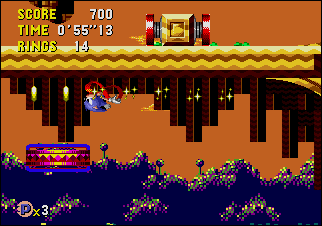 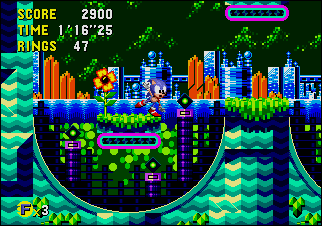 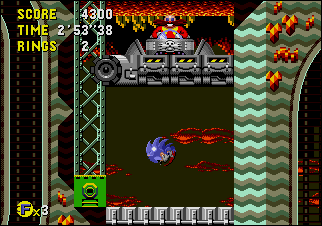 |
Tidal Tempest -- The latest
incarnation of those infernal underwater ruins. As usual, stay
underwater for too long and a countdown will begin. If you
don't reach the surface or find an air bubble before the
countdown is out, you lose a chance. Enemies you'll encounter
include:
- Tagataga -- Weird crustacean bots that swim back and
forth in a small area. When they spot Sonic, they pause
briefly to fire off a couple of flashing projectiles, then
dash off the screen.
- ??? -- Nameless dragonfly enemies that simply fly back
and forth in a small area. They move faster than Batabata.
Boss: In the first phase, you have to chase Eggman
down through an endless maze, making sure to get close enough
to attack. After taking four hits, the Doc will retreat to an
underwater arena where he'll pull air bubbles from the ground
and surround his mobile with them. Those air bubbles serve as
two things: oxygen for your own life and a shield for Eggman.
Inhale enough bubbles to leave a big enough opening to attack
through, but avoid the little projectiles he fires at you. All
he takes is one hit.
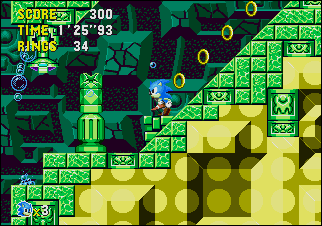 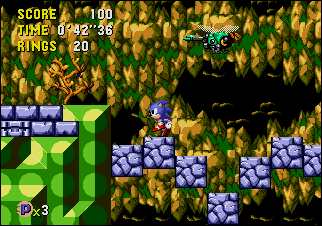 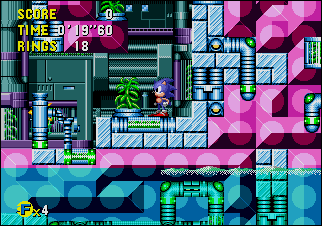 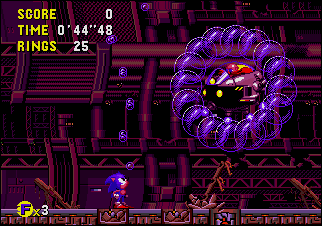 |
Quartz Quadrant -- There's a mining
operation going on in these natural caverns. Conveyor belts
alter your speed, but their direction can be changed by
touching the signs. Enemies you'll encounter include:
- Kumokumo -- Spider bots that leap vertically, but are
incapable of horizontal movement. They attack by firing off
a web thing that briefly slows Sonic down if it contacts.
("Kumo" is the Japanese word for spider.)
- Noronoro -- Snail bots with spiked shells that simply
trudge back and forth in a small area. The spikes retract
and extend at regular intervals. ("Noronoro" means slowly or
sluggishly.)
- Sasori -- Scorpion bots that roll back and forth over a
small area. Every once in a bit they pause to fire a
flashing projectile. ("Sasori" is the Japanese word for
scorpion.)
- ??? -- Nameless caterpillar bots that bear a striking
resemblance to Sonic 1's Naaru. The move in the same way,
but their segments don't scatter when hit incorrectly. Some
of them have spiked backs, others are smooth as a baby's
butt.
Boss: You're in a small arena where Sonic is running
against the flow of a conveyor belt (that leads into spikes)
with Eggman standing in sort of a tube thing (like from Sonic
1's Final Zone) on the other end. Just hit him once to knock
him down into the conveyor belt, then kick up the speed. As
Sonic runs, the conveyor belt speeds up, brushing against the
bottom of Eggman's tube until it eventually wears through. The
only attack Eggman has is to occasionally throw a mine that,
when it hits the ground, splits into four smaller mines.
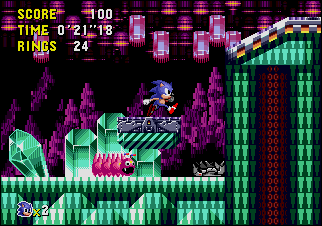 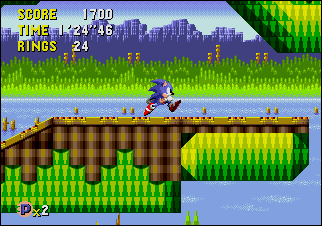 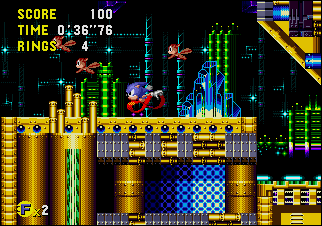 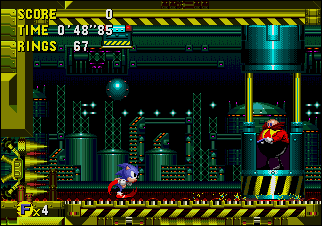 |
Wacky Workbench -- Unlike most
levels in the game, Wacky Workbench works on a vertical level
as opposed to horizontal. If you touch the ground when it's
flashing, you'll be bounced high into the air, where most of
the action takes place on moving platforms. In another nod to
8-bit Sonic 1, electrical conduits that are strewn about the
background will shock you if you touch them when they're
flashing. In Zone 1 Past, keep an eye open for a small hidden
alcove with a goddess statue in it. The statue spouts Rings
like a fountain. In the Future, the statue is replaced by a
golden Eggman statue. Destroy it and mines fall from the
ceiling. Weird... Enemies you'll encounter include:
- Battapyon -- Springy grasshopper bots that bounce around
all over the place. ("Batta" is the Japanese word for
grasshopper, "pyonpyon" means hopping.)
- ??? -- Nameless bumble bee robots that look exactly like
Metalic Madness's Poubii enemies, only without the swinging
mace.
- ??? -- Nameless cylindrical bots that hang from ceilings
and drop down when Sonic approaches. They extend and retract
spikes periodically, and are invulnerable when spiked.
Boss: This time, Eggman tries to escape in a
vertical arena with three rooms. In the first room, hit him
once and he dashes upward, breaking through the ceiling above.
Four chunks of ceiling will fall: don't let 'em smush you, but
jump on top of one of the two inner pieces. Now, the floor
will be electrified and the four chunks of ceiling will be
catapulted into the air. You need to leap through the hole in
the ceiling (which then technically becomes the floor), but
your weight will slow down the chunk of ceiling you're on, so
you need to first jump to the nearest one. (If you're on one
of the two outer pieces of ceiling, you will be smushed.)
Repeat this process two more times, keeping in mind that on
the third round, spikes will also fall from the ceiling in
addition to the chunks of metal.
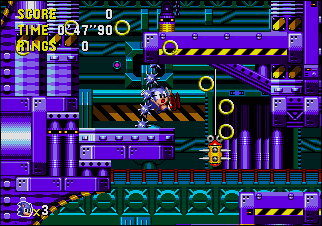 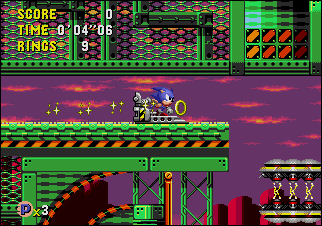 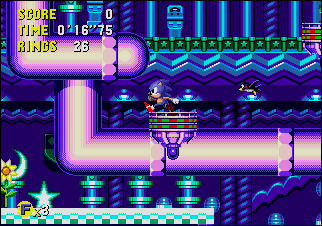 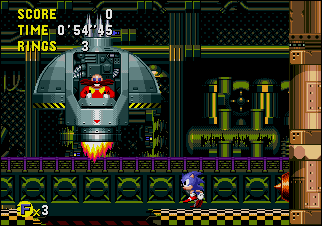 |
Stardust Speedway -- Sonic CD's
version of the aerial highway stage features a giant
cathedral-esque structure in the middle of the city. In the
Present, it's a giant golden Eggman statue in the construction
phase. In the Past, it's a Russian style palace. In the
Future, it's a fully built golden Eggman statue. In the Good
Future, it's a more modern building with Greek style
architecture. Enemies you'll encounter include:
- ??? -- Nameless louse enemies that crawl over a small
area, but roll into a ball to attack as soon as Sonic
approaches.
- ??? -- Nameless flying enemies that rotate around
platforms in a corkscrew pattern.
- ??? -- Nameless bird enemies followed by numerous shadow
images of themselves. They attack by firing off the shadow
images in all directions.
Boss: This isn't a boss: it's a race. Your
opponent is Metal Sonic, meaning that he isn't going to play
fair. The course is straightforward, but littered with
obstacles which you have to jump over or otherwise avoid while
Metal can simply tear right through. Additionally, every time
you pull ahead, Metal will glow with electricity and nail you.
Don't slow down either, because Eggman is trailing not far
behind in his Eggmobile, tearing up the highway with a
powerful laser beam. Beat Metal to the end and he slams into a
wall, at which point Eggman runs off (as usual). At this
point, Amy Rose is freed and there's only one line of business
left to attend...
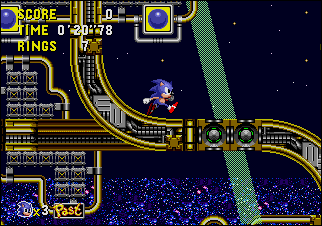 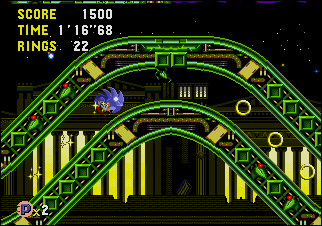 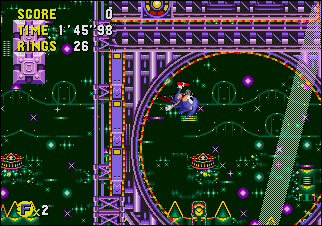 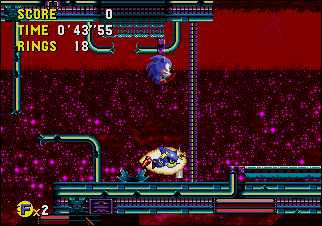 |
Metallic Madness -- Like the
Metropolis Zone, Metallic Madness seems to take place mostly
inside a giant factory of some sort. In Zone 2, you get to
send Sonic through shrink lasers which reduce him down to his
"continue" sprite in order to navigate narrow tunnels.
Immediately before fighting the boss, you'll encounter a trio
of tricky firefly bots which fly back and forth to different
points in the arena, pausing only to fire laser beams below.
Other enemies you'll encounter include:
- Mekabu -- Beetle bots guarded in the front by a spinning
blade. They move back and forth over a small area, raising
and lowering the blade.
- Poubii -- Bumble bee bots that fly from the right side
of the screen to the left, swinging a mace from their
abdomens.
- ??? -- Nameless crawling enemies with hinges on their
backsides. They always face a single direction and crawl
slowly along a small area. Try to attack them from behind,
and they'll catch Sonic in his spin attack and send him
rolling in the opposite direction.
- ??? -- Nameless bots which are identical to Sonic 1's
Bomb enemies, only much larger. They're usually found alone,
but their explosions cover a much wider area than their
miniscule cousins.
Boss: Eggman's final machine is simple enough: it's
his normal Eggmobile with four panels circling the exterior.
The trick is to reach between the panels to land a hit. Each
time Eggman takes damage, one of the panels falls off and his
method of attack changes. In the first two rounds, he'll lower
himself to the ground and roll across the arena. In round
three, he shoots off his remaining two panels which then fall
vertically onto the arena. In the final round, he'll fire off
his last panel which then falls into the arena at an angle.
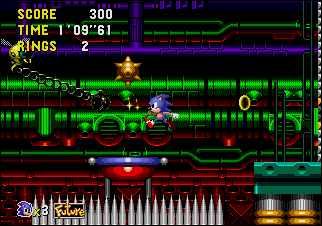 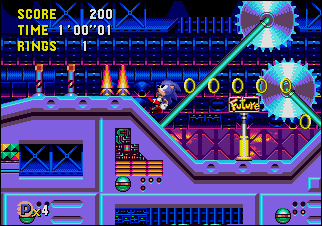 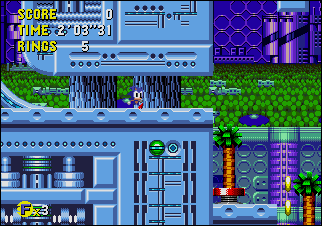 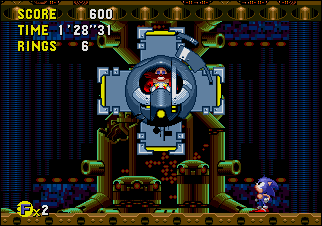 |
If all that running back and forth between time
zones is too much hassle but you still want the good ending, you
could opt to shoot for the seven Time Stones. To get a chance at a
Time Stone, get to the end of any Zone (barring boss stages) with at
least 50 Rings on-hand. There will be a giant Ring hovering above
the sign, and you know what to do with that.
|
The Special Zones
(Special Stages in any other Sonic game), as usual, are
psuedo-3D. These guys take advantage of the Sega CD's sprite
scrolling capabilities and find Sonic on a flat, square arena.
He moves forward automatically, so your only job is to steer
him in the right direction and have him jump when necessary.
Hovering off the ground are six UFOs which must be destroyed
within the time limit. Now here's the catch: there are a
number of obstacles on the ground and the UFOs move in
seemingly erratic patterns around the arena, so it becomes a
huge task of trial & error to learn the quickest route
around the field. After destroying a UFO, you'll receive one
of two items: Highspeed which bestow you with a temporary
burst of speed, or a Big 10 Ring which gives you a 10 Ring
bonus. Additionally, when the time limit drops to 20 seconds,
a special blue UFO will appear over the center of the arena:
destroy it to get another 30 seconds added to the clock.
Obstacles to watch out for (or take advantage of) on the
ground include:
terrain -- When you're not on the road, you're on the
ground, which slows you down to minimum speed.
Water -- Water is your biggest enemy in the Special Zones.
Stepping in it not only slows Sonic down to minimum speed, but
for each second you spend in the pond a merciless 10 seconds
are shaved off the timer.
chopper blocks -- These things make Sonic fall flat on his
face, forcing you to come to a total stop and robbing you of
some Rings to boot.
fan blocks -- Send you soaring through the air. They're
great for getting around the arena and reaching hard-to-hit
UFOs, but watch where you land...
spring blocks -- Bounce you high into the air.
dash panels -- Send you zipping at max speed in the
direction of the arrow.
bumpers -- Bounce you around, but usually (usually)
protect you from falling into the water.
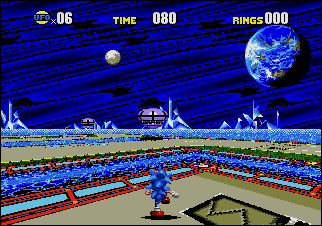
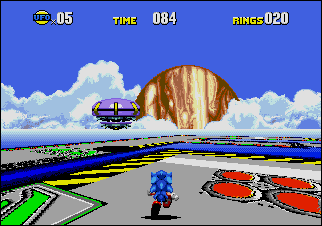
One other thing Sonic CD touts that older
games in the series can't are numerous gameplay modes. You can
start a New Game which saves automatically after each stage
you complete, after which you'll be able to select the
Continue option from the title screen. Unfortunately, it only
holds one game at a time, and it's erased as soon as you start
a new one. The Time Attack mode lets you race the clock in
levels and Special Zones you've already completed, after which
you get to enter your initials. (Get the most sets of initials
on the board, and you get a special screen after completing
the regular game. It features Sonic, Amy, and Metal Sonic
running around the screen, while numerous animals frolic
happily; along with the text: "Congratulations [your initials
here]! You are greatest player!") There are also a couple of
hidden modes that are unlocked after you've topped enough of
your old Time Attack scores: D.A. Garden and Visual Mode. D.A.
Garden is an elaborate sound test, while Visual Mode allows
you to view the game's anime intro and both endings, along
with a special "pencil test" of the incomplete movies.
|
--
Comparison -- The screenshots
above are all taken from the PC version of the game. There is no
graphical or mechanical difference between the original Mega CD
version and its PC counterpart; the two games are completely
identical. The only addition to the PC version is the complete,
uncut opening sequence, running at full animation.
-- Codes
--Level-select: (Mega-CD version) At the
title screen, press: Up, Down, Down, Left, Right, B.
(PC version)
At the title screen, press: Up, Down, Down, Left, Right, SPACE.
Pro Scores: (Mega-CD version) At the title screen, press:
Right, Right, Up, Up, Down, C, START.
(PC version) At the title
screen, press: Right, Right, Up, Up, Down, SPACE.
Sound Test: (Mega-CD version) At the title screen, press:
Down, Down, Down, Left, Right, A.
(PC version) At the title
screen, press: Down, Down, Down, Left, Right, SPACE.
Construction Mode: (Mega-CD version) Input the Sound Test
code. Adjust the numbers to match these settings: FM#40, PCM#12,
DA#11. Press START. A picture of Tails will appear with the text
"See You Next Game -- Judy Totoya". Begin a normal game. Controls
are as follows:
A = Changes highlighted item.
B = Toggles between items
and Sonic.
C = Places highlighted item.
Hidden Special Stage: (Mega-CD version) Input the Sound
Test code. Adjust the numbers to match these settings: FM#07,
PCM#07, DA#07. Press START.
(PC version) At the Sound Test menu,
adjust the numbers to match these settings: PCM#07, DA#07.
Art Screens: (Mega-CD version) To access these hidden art
screens, input the Sound Test code and adjust the numbers to match
the indicated settings:
- DJ Sonic: FM#42, PCM#03, DA#01
- Sega Forever: FM#46, PCM#12, DA#25
- Demonic Sonic: FM#42, PCM#04, DA#21
- Yuakuru: FM#44, PCM#11, DA#09
(PC version) At the
Sound Test menu, adjust the numbers to match the indicated settings:
- See You Next Game: PCM#12, DA#11
- DJ Sonic: PCM#03, DA#01
- Demonic Sonic: PCM#04, DA#21
- Sega Forever: PCM#12, DA#25
- Yuakuru: PCM#11, DA#09
I'm outta here!: (both versions) At any point in any Zone,
leave Sonic standing perfectly still (don't pause the game!). After
three minutes, he'll say: "I'm outta here!" and race off the screen.
This ends your game...
--
Behind the Screens -- The US
release of the game was held up a few months while a whole new
soundtrack was being produced by Spencer Nilsen, who was behind many
other major Sega CD soundtracks, as well as a few early Saturn
scores. But alas, the new tunes received much flak from purists who
wanted the original Naofumi Hataya score left intact. The battle
wages on even today.
After failing to become the killer app the Sega
CD so desperately needed, Sonic CD was later revived on PC. The PC
version included the full anime intro (not available to
console players until Sonic Jam), along with Spencer Nilsen's
soundtrack.
--
Miscellanea --
- In the US manual, Amy Rose is referred to as "Princess Sally."
This was probably intended to tie in with the newly released
comics and cartoons, although being that the "Sally" character was
already established, the only thing it achieved was to shove Amy
out of the potential cast completely. Luckily, she did finally
make it into the regular gang a good while later (long after the
death of the intolerable cartoon show).
Compiled and written by Jared "Green Gibbon!"
Matte. Screenshots are of the PC version. Manual translation thanks
to Michael Stearns. Hosting provided by Emulation Zone and Emulation
World.
|



